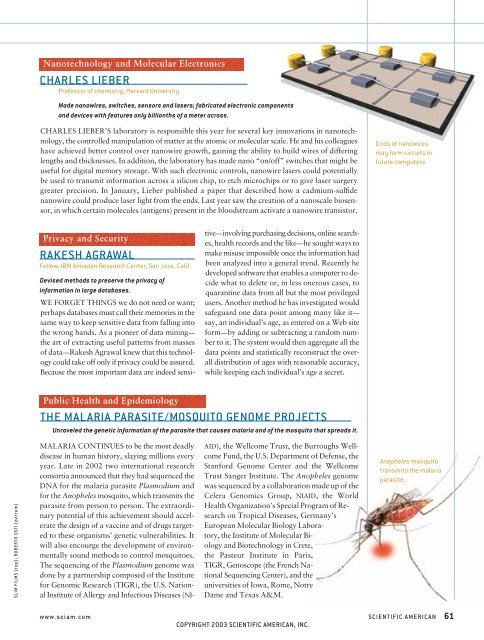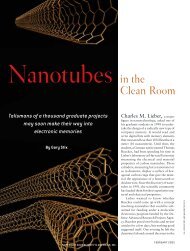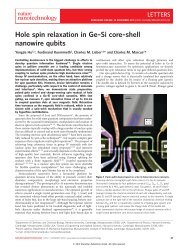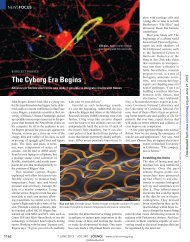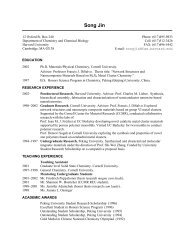download pdf - Lieber Research Group - Harvard University
download pdf - Lieber Research Group - Harvard University
download pdf - Lieber Research Group - Harvard University
You also want an ePaper? Increase the reach of your titles
YUMPU automatically turns print PDFs into web optimized ePapers that Google loves.
Nanotechnology and Molecular Electronics<br />
CHARLES LIEBER<br />
Professor of chemistry, <strong>Harvard</strong> <strong>University</strong><br />
Made nanowires, switches, sensors and lasers; fabricated electronic components<br />
and devices with features only billionths of a meter across.<br />
CHARLES LIEBER’S laboratory is responsible this year for several key innovations in nanotechnology,<br />
the controlled manipulation of matter at the atomic or molecular scale. He and his colleagues<br />
have achieved better control over nanowire growth, gaining the ability to build wires of differing<br />
lengths and thicknesses. In addition, the laboratory has made nano “on/off” switches that might be<br />
useful for digital memory storage. With such electronic controls, nanowire lasers could potentially<br />
be used to transmit information across a silicon chip, to etch microchips or to give laser surgery<br />
greater precision. In January, <strong>Lieber</strong> published a paper that described how a cadmium-sulfide<br />
nanowire could produce laser light from the ends. Last year saw the creation of a nanoscale biosensor,<br />
in which certain molecules (antigens) present in the bloodstream activate a nanowire transistor.<br />
Grids of nanowires<br />
may form circuits in<br />
future computers.<br />
Privacy and Security<br />
RAKESH AGRAWAL<br />
Fellow, IBM Almaden <strong>Research</strong> Center, San Jose, Calif.<br />
Devised methods to preserve the privacy of<br />
information in large databases.<br />
WE FORGET THINGS we do not need or want;<br />
perhaps databases must cull their memories in the<br />
same way to keep sensitive data from falling into<br />
the wrong hands. As a pioneer of data mining—<br />
the art of extracting useful patterns from masses<br />
of data—Rakesh Agrawal knew that this technology<br />
could take off only if privacy could be assured.<br />
Because the most important data are indeed sensitive—involving<br />
purchasing decisions, online searches,<br />
health records and the like—he sought ways to<br />
make misuse impossible once the information had<br />
been analyzed into a general trend. Recently he<br />
developed software that enables a computer to decide<br />
what to delete or, in less onerous cases, to<br />
quarantine data from all but the most privileged<br />
users. Another method he has investigated would<br />
safeguard one data point among many like it—<br />
say, an individual’s age, as entered on a Web site<br />
form—by adding or subtracting a random number<br />
to it. The system would then aggregate all the<br />
data points and statistically reconstruct the overall<br />
distribution of ages with reasonable accuracy,<br />
while keeping each individual’s age a secret.<br />
Public Health and Epidemiology<br />
THE MALARIA PARASITE/MOSQUITO GENOME PROJECTS<br />
Unraveled the genetic information of the parasite that causes malaria and of the mosquito that spreads it.<br />
SLIM FILMS (top); ROBERTO OSTI (bottom)<br />
MALARIA CONTINUES to be the most deadly<br />
disease in human history, slaying millions every<br />
year. Late in 2002 two international research<br />
consortia announced that they had sequenced the<br />
DNA for the malaria parasite Plasmodium and<br />
for the Anopheles mosquito, which transmits the<br />
parasite from person to person. The extraordinary<br />
potential of this achievement should accelerate<br />
the design of a vaccine and of drugs targeted<br />
to these organisms’ genetic vulnerabilities. It<br />
will also encourge the development of environmentally<br />
sound methods to control mosquitoes.<br />
The sequencing of the Plasmodium genome was<br />
done by a partnership composed of the Institute<br />
for Genomic <strong>Research</strong> (TIGR), the U.S. National<br />
Institute of Allergy and Infectious Diseases (NI-<br />
AID), the Wellcome Trust, the Burroughs Wellcome<br />
Fund, the U.S. Department of Defense, the<br />
Stanford Genome Center and the Wellcome<br />
Trust Sanger Institute. The Anopheles genome<br />
was sequenced by a collaboration made up of the<br />
Celera Genomics <strong>Group</strong>, NIAID, the World<br />
Health Organization’s Special Program of <strong>Research</strong><br />
on Tropical Diseases, Germany’s<br />
European Molecular Biology Laboratory,<br />
the Institute of Molecular Biology<br />
and Biotechnology in Crete,<br />
the Pasteur Institute in Paris,<br />
TIGR, Genoscope (the French National<br />
Sequencing Center), and the<br />
universities of Iowa, Rome, Notre<br />
Dame and Texas A&M.<br />
Anopheles mosquito<br />
transmits the malaria<br />
parasite.<br />
www.sciam.com SCIENTIFIC AMERICAN 61<br />
COPYRIGHT 2003 SCIENTIFIC AMERICAN, INC.


